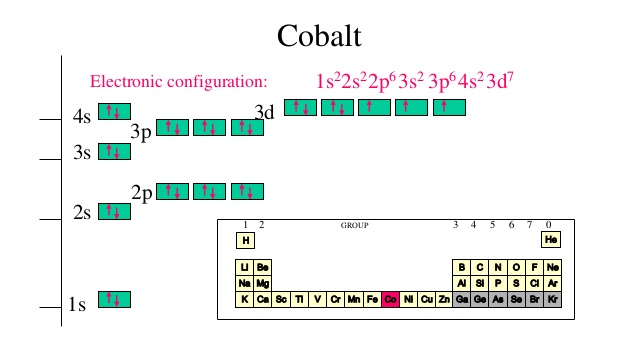The atom cobalt has 27 electrons. How many energy levels will its electrons use?
1 Answer
Four energy levels.
Explanation:
The number of electrons each energy level can hold increases as you add more and more energy levels to an atom.
The relationship that exists between the energy level,
#color(blue)(|bar(ul(color(white)(a/a)"no. of e"^(-) = 2n^2color(white)(a/a)|)))#
You can use this equation to find the maximum number of electrons that can be added to each energy level. You will have
- the first energy level,
#n=1#
#"no. of e"^(-) = 2 * 1^2 = "2 e"^(-)#
- the second energy level
#n=2#
#"no. of e"^(-) = 2 * 2^2 = "8 e"^(-)#
- the third energy level,
#n=3#
#"no. of e"^(-) = 2 * 3^2 = "18 e"^(-)#
- the fourth energy level,
#n=4#
#"no. of e"^(-1) = 2 * 4^2 = "32 e"^(-)#
and so on.
In your case, cobalt,
Now, it's very important to remember that when you're adding electrons to an atom, the 3d-orbitals, which are located on the third energy level, are higher in energy than the 4s-orbital.
This means that you must fill the 4s-orbital first, then distribute the rest of the electrons to the 3d-orbitals.
So, a neutral cobalt atom will have
#n=1 -> "2 e"^(-)# in the#1s# subshell
#n=2 -> "8 e"^(-)# in the#2s# and#2p# subshells
Now, these two energy levels will hold
#"2 e"^(-) + "8 e"^(-) = "10 e"^(-)#
Now comes the tricky part. The third energy level can hold
#"27 e"^(-) - "10 e"^(-) = "17 e"^(-)#
that the neutral cobalt atom has. You could thus say that
#color(red)(cancel(color(black)(n=3 -> "17 e"^(-))))# in the#3s# ,#3p# , and#3d# subshells
and conclude that the electrons that surround the nucleus of a cobalt atom are spread out on
Taking it one subshell at a time, you will have
#"2 e"^(-) -># in the#3s# subshell
#"6 e"^(-) -># in the#3p# subshell
You now have
#"17 e"^(-) - ("2 e"^(-) + "6 e"^(-)) = "9 e"^(-)#
to distribute. Because the 4s orbital is filled before the 3d-orbitals, the next two electrons are going to be distributed on the fourth energy level
#n=4 -> "2 e"^(-)# in the#4s# subshell
The remaining
Therefore, a neutral cobalt atom will have
#n=1 -> "2 e"^(-)# in the#1s# subshell
#n=2 -> "8 e"^(-)# in the#2s# and#2p# subshells
#n= 3 -> "15 e"^(-)# in the#3s# ,#3p# , and#3d# subshells
#n=4 -> "2 e"^(-)# in the#4s# subshell


